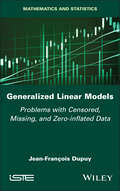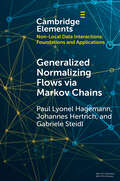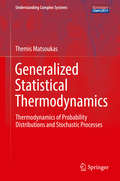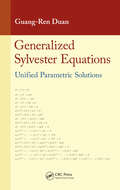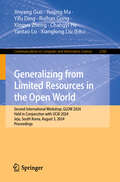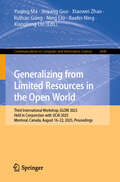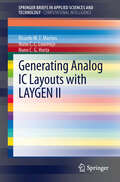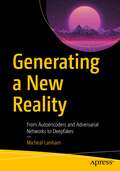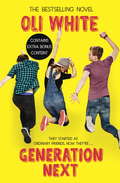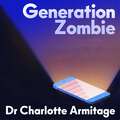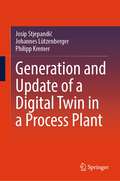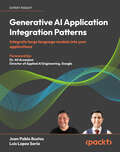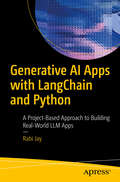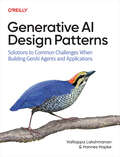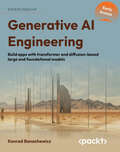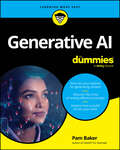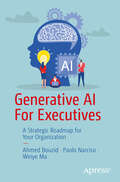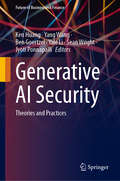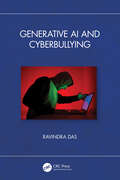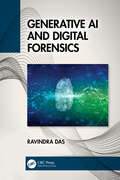- Table View
- List View
Generalized Linear Models: Problems with Censored, Missing, and Zero-inflated Data (ISTE Invoiced)
by Jean-Francois DupuySince they were first formulated in 1972, generalized linear models have enjoyed a veritable boom, with numerous applications in insurance, economics and biostatistics. Today, they are still the subject of a great deal of research. This book provides an overview of the theory of generalized linear models. Particular attention is paid to the problems of censoring, missing data and excess zeros. Didactic and accessible, Generalized Linear Models is illustrated with exercises and numerous R codes. With all the necessary prerequisites introduced in a step-by-step fashion, this book is aimed at students (at master's or engineering school level), as well as teachers and practitioners of mathematics and statistical modeling.
Generalized Normalizing Flows via Markov Chains (Elements in Non-local Data Interactions: Foundations and Applications)
by Gabriele Steidl Paul Lyonel Hagemann Johannes HertrichNormalizing flows, diffusion normalizing flows and variational autoencoders are powerful generative models. This Element provides a unified framework to handle these approaches via Markov chains. The authors consider stochastic normalizing flows as a pair of Markov chains fulfilling some properties, and show how many state-of-the-art models for data generation fit into this framework. Indeed numerical simulations show that including stochastic layers improves the expressivity of the network and allows for generating multimodal distributions from unimodal ones. The Markov chains point of view enables the coupling of both deterministic layers as invertible neural networks and stochastic layers as Metropolis-Hasting layers, Langevin layers, variational autoencoders and diffusion normalizing flows in a mathematically sound way. The authors' framework establishes a useful mathematical tool to combine the various approaches.
Generalized Statistical Thermodynamics: Thermodynamics of Probability Distributions and Stochastic Processes (Understanding Complex Systems)
by Themis MatsoukasThis book gives the definitive mathematical answer to what thermodynamics really is: a variational calculus applied to probability distributions. Extending Gibbs's notion of ensemble, the Author imagines the ensemble of all possible probability distributions and assigns probabilities to them by selection rules that are fairly general. The calculus of the most probable distribution in the ensemble produces the entire network of mathematical relationships we recognize as thermodynamics. The first part of the book develops the theory for discrete and continuous distributions while the second part applies this thermodynamic calculus to problems in population balance theory and shows how the emergence of a giant component in aggregation, and the shattering transition in fragmentation may be treated as formal phase transitions. While the book is intended as a research monograph, the material is self-contained and the style sufficiently tutorial to be accessible for self-paced study by an advanced graduate student in such fields as physics, chemistry, and engineering.
Generalized Sylvester Equations: Unified Parametric Solutions
by Guang-Ren DuanProvides One Unified Formula That Gives Solutions to Several Types of GSEsGeneralized Sylvester equations (GSEs) are applied in many fields, including applied mathematics, systems and control, and signal processing. Generalized Sylvester Equations: Unified Parametric Solutions presents a unified parametric approach for solving various types of GSEs
Generalizing from Limited Resources in the Open World: Second International Workshop, GLOW 2024, Held in Conjunction with IJCAI 2024, Jeju, South Korea, August 3, 2024, Proceedings (Communications in Computer and Information Science #2160)
by Jinyang Guo Yuqing Ma Yifu Ding Ruihao Gong Xingyu Zheng Changyi He Yantao Lu Xianglong LiuThis book presents the Proceedings from the Second International Workshop GLOW 2024 held in conjunction with the International Joint Conference on Artificial Intelligence, IJCAI 2024, in Jeju Island, South Korea, in August 2024. The 11 full papers and 4 short papers included in this book were carefully reviewed and selected from 22 submissions. They were organized in topical sections as follows: efficient methods for low-resource hardware; efficient fintuning with limited data; advancements in multimodal systems; recognition and reasoning in the open world.
Generalizing from Limited Resources in the Open World: Third International Workshop, GLOW 2025, Held in Conjunction with IJCAI 2025, Montreal, Canada, August 16–22, 2025, Proceedings (Communications in Computer and Information Science #2640)
by Ning Liu Jinyang Guo Yuqing Ma Ruihao Gong Xianglong Liu Xiaowei Zhao Xuefei NingThis book presents the proceedings from the Third International Workshop on Generalizing from Limited Resources in the Open World (GLOW) 2025 held in conjunction with the International Joint Conference on Artificial Intelligence, IJCAI 2025, in Montreal, Canada, during August 16-22, 2025. The 12 full papers in this book were carefully reviewed and selected from 27 submissions. These papers focus on the academic exploration of efficient methodologies within the realm of artificial intelligence models. We concentrated on both data-efficient strategies, such as zero/few-shot learning and domain adaptation, as well as model-efficient approaches like model sparsification and compact model design.
Generating Analog IC Layouts with LAYGEN II
by Nuno C.G. Horta Nuno C. Lourenço Ricardo M. MartinsThis book presents an innovative methodology for the automatic generation of analog integrated circuits (ICs) layout, based on template descriptions and on evolutionary computational techniques. A design automation tool, LAYGEN II was implemented to validate the proposed approach giving special emphasis to reusability of expert design knowledge and to efficiency on retargeting operations.
Generating a New Reality: From Autoencoders and Adversarial Networks to Deepfakes
by Micheal LanhamThe emergence of artificial intelligence (AI) has brought us to the precipice of a new age where we struggle to understand what is real, from advanced CGI in movies to even faking the news. AI that was developed to understand our reality is now being used to create its own reality. In this book we look at the many AI techniques capable of generating new realities. We start with the basics of deep learning. Then we move on to autoencoders and generative adversarial networks (GANs). We explore variations of GAN to generate content. The book ends with an in-depth look at the most popular generator projects.By the end of this book you will understand the AI techniques used to generate different forms of content. You will be able to use these techniques for your own amusement or professional career to both impress and educate others around you and give you the ability to transform your own reality into something new.What You Will LearnKnow the fundamentals of content generation from autoencoders to generative adversarial networks (GANs)Explore variations of GANUnderstand the basics of other forms of content generationUse advanced projects such as Faceswap, deepfakes, DeOldify, and StyleGAN2Who This Book Is ForMachine learning developers and AI enthusiasts who want to understand AI content generation techniques
Generation Digital
by Kathryn C. MontgomeryChildren and teens today have integrated digital culture seamlessly into their lives. For most, using the Internet, playing videogames, downloading music onto an iPod, or multitasking with a cell phone is no more complicated than setting the toaster oven to "bake" or turning on the TV. In Generation Digital,media expert and activist Kathryn C. Montgomery examines the ways in which the new media landscape is changing the nature of childhood and adolescence and analyzes recent political debates that have shaped both policy and practice in digital culture. The media have pictured the so-called "digital generation" in contradictory ways: as bold trailblazers and innocent victims, as active creators of digital culture and passive targets of digital marketing. This, says Montgomery, reflects our ambivalent attitude toward both youth and technology. She charts a confluence of historical trends that made children and teens a particularly valuable target market during the early commercialization of the Internet and describes the consumer-group advocacy campaign that led to a law to protect children's privacy on the Internet. Montgomery recounts--as a participant and as a media scholar--the highly publicized battles over indecency and pornography on the Internet. She shows how digital marketing taps into teenagers' developmental needs and how three public service campaigns--about sexuality, smoking, and political involvement--borrowed their techniques from commercial digital marketers. Not all of today's techno-savvy youth are politically disaffected; Generation Digitalchronicles the ways that many have used the Internet as a political tool, mobilizing young voters in 2004 and waging battles with the music and media industries over control of cultural expression online. Montgomery's unique perspective as both advocate and analyst will help parents, politicians, and corporations take the necessary steps to create an open, diverse, equitable, and safe digital media culture for young people.
Generation Next
by Oli White**The bestselling debut novel from YouTube sensation Oli White. CONTAINS EXCLUSIVE BONUS CONTENT!**Things haven't been easy for Jack recently - life as a teenager has its ups and downs. But when he meets a new group of friends, who are every bit as geek as they are chic, his luck seems to be changing. Each of the group is talented and when they pool together to create Generation Next, an incredible new kind of social media platform, it's clear that they're on to something special.What if your Instagram account grew by hundreds of thousands of followers overnight, and big companies were fighting each other to offer you photoshoots? When GenNext suddenly goes viral, Jack and his friends are thrust into a crazy world of fame which is as terrifying as it is awesome. Because someone out there is determined to trip Jack up at every step. If he doesn't stop them, soon everyone he cares about - his friends, his family, and the girl he's falling for - will be in danger...
Generation Next
by Oli WhiteThe stunning debut novel from YouTube sensation Oli White. Includes an exclusive audiobook introduction read by Oli White.Things haven't been easy for Jack recently - life as a teenager has its ups and downs. But when he meets a new group of friends, who are every bit as geek as they are chic, his luck seems to be changing. Each of the group is talented and when they pool together to create Generation Next, an incredible new kind of social media platform, it's clear that they're on to something special. What if your Instagram account grew by hundreds of thousands of followers overnight, and big companies were fighting each other to offer you photoshoots? When GenNext suddenly goes viral, Jack and his friends are thrust into a crazy world of fame which is as terrifying as it is awesome. Because someone out there is determined to trip Jack up at every step. If he doesn't stop them, soon everyone he cares about - his friends, his family, and the girl he's falling for - will be in danger...(P)2016 Hodder & Stoughton
Generation Z: What It's Like to Grow up in the Age of Likes, LOLs and Longing
by The Washington PostAn in-depth profile of the digital native generation from the Pulitzer Prize-winning newspaper. For the generation after Millennials, technology has been the only way of life since birth. These children are the first group to have their formative moments chronicled on Facebook, to grow up surrounded by the ubiquity of smartphones, and most important, to navigate a social landscape ruled by the internet. With this lifestyle comes a host of issues that prior generations never dealt with, including cyberbullying, alienation from peers with greater access to technology, and an increasing vulnerability to online sexual predators. This series of articles from the Washington Post delves into the everyday lives of American kids and teenagers. With its exploration of the unique pressures and complications of living an online life (and most of life online), this collection is a must-read for anyone who cares about the future of Generation Z.
Generation Zombie: The new essential guide to why screens and devices are harming our children and what we can do about it
by Dr Charlotte Armitage'It is never too late to make changes and put things right. If we recognise the problem of device use, we can regain control of our families and allow our children to grow up as they should.' Dr Charlotte ArmitageMany theories that form the bedrock of good parenting were created decades before devices even existed - they don't consider the significant impact on a child's psychological and physical development. The landscape of the early years has changed so quickly, yet parents and caregivers do not have access to the evidence-based, practical advice they need to manage this invasion of screens. They can see their children become addicted to devices, but don't know what to do. Generation Zombie will fill this knowledge gap.Through her clinical work as a psychotherapist, work with schools and as a duty of care psychologist, Dr Charlotte Armitage has witnessed the terrifying impact of screen time on her clients and their families. However, unlike other addictions, the harmful consequences of devices are not widely recognised. With the vital insights in her book - including practical tips and engaging case studies - her mission is hopeful and empowering; to enable parents to make a positive change. Away from devices, you will be amazed how quickly you notice children's behaviour change.
Generation Zombie: The new essential guide to why screens and devices are harming our children and what we can do about it
by Dr Charlotte Armitage'It is never too late to make changes and put things right. If we recognise the problem of device use, we can regain control of our families and allow our children to grow up as they should.' Dr Charlotte ArmitageMany theories that form the bedrock of good parenting were created decades before devices even existed - they don't consider the significant impact on a child's psychological and physical development. The landscape of the early years has changed so quickly, yet parents and caregivers do not have access to the evidence-based, practical advice they need to manage this invasion of screens. They can see their children become addicted to devices, but don't know what to do. Generation Zombie will fill this knowledge gap.Through her clinical work as a psychotherapist, work with schools and as a duty of care psychologist, Dr Charlotte Armitage has witnessed the terrifying impact of screen time on her clients and their families. However, unlike other addictions, the harmful consequences of devices are not widely recognised. With the vital insights in her book - including practical tips and engaging case studies - her mission is hopeful and empowering; to enable parents to make a positive change. Away from devices, you will be amazed how quickly you notice children's behaviour change.
Generation Zombie: The new essential guide to why screens and devices are harming our children and what we can do about it
by Dr Charlotte Armitage'It is never too late to make changes and put things right. If we recognise the problem of device use, we can regain control of our families and allow our children to grow up as they should.' Dr Charlotte ArmitageMany theories that form the bedrock of good parenting were created decades before devices even existed - they don't consider the significant impact on a child's psychological and physical development. The landscape of the early years has changed so quickly, yet parents and caregivers do not have access to the evidence-based, practical advice they need to manage this invasion of screens. They can see their children become addicted to devices, but don't know what to do. Generation Zombie will fill this knowledge gap.Through her clinical work as a psychotherapist, work with schools and as a duty of care psychologist, Dr Charlotte Armitage has witnessed the terrifying impact of screen time on her clients and their families. However, unlike other addictions, the harmful consequences of devices are not widely recognised. With the vital insights in her book - including practical tips and engaging case studies - her mission is hopeful and empowering; to enable parents to make a positive change. Away from devices, you will be amazed how quickly you notice children's behaviour change.
Generation and Update of a Digital Twin in a Process Plant
by Josip Stjepandić Johannes Lützenberger Philipp KremerThis book covers the most important subjects of digital twin in a process plant, including foundations, methods, achievements, and applications in a brownfield environment. Besides offering a variety of applications and procedural variants from research and industrial practice, this book also provides a comprehensive insight into holistic plant planning. It also discusses the challenges that currently exist in different application areas. This book would be of interest to industry professionals and researchers in industrial and manufacturing engineering.
Generative AI Application Integration Patterns: Integrate large language models into your applications
by Juan Pablo Bustos Luis Lopez SoriaUnleash the transformative potential of GenAI with this comprehensive guide that serves as an indispensable roadmap for integrating large language models into real-world applications. Gain invaluable insights into identifying compelling use cases, leveraging state-of-the-art models effectively, deploying these models into your applications at scale, and navigating ethical considerations.Key FeaturesGet familiar with the most important tools and concepts used in real scenarios to design GenAI appsInteract with GenAI models to tailor model behavior to minimize hallucinationsGet acquainted with a variety of strategies and an easy to follow 4 step frameworks for integrating GenAI into applicationsBook DescriptionExplore the transformative potential of GenAI in the application development lifecycle. Through concrete examples, you will go through the process of ideation and integration, understanding the tradeoffs and the decision points when integrating GenAI. With recent advances in models like Google Gemini, Anthropic Claude, DALL-E and GPT-4o, this timely resource will help you harness these technologies through proven design patterns. We then delve into the practical applications of GenAI, identifying common use cases and applying design patterns to address real-world challenges. From summarization and metadata extraction to intent classification and question answering, each chapter offers practical examples and blueprints for leveraging GenAI across diverse domains and tasks. You will learn how to fine-tune models for specific applications, progressing from basic prompting to sophisticated strategies such as retrieval augmented generation (RAG) and chain of thought. Additionally, we provide end-to-end guidance on operationalizing models, including data prep, training, deployment, and monitoring. We also focus on responsible and ethical development techniques for transparency, auditing, and governance as crucial design patterns.What you will learnConcepts of GenAI: pre-training, fine-tuning, prompt engineering, and RAGFramework for integrating AI: entry points, prompt pre-processing, inference, post-processing, and presentationPatterns for batch and real-time integrationCode samples for metadata extraction, summarization, intent classification, question-answering with RAG, and moreEthical use: bias mitigation, data privacy, and monitoringDeployment and hosting options for GenAI modelsWho this book is forThis book is not an introduction to AI/ML or Python. It offers practical guides for designing, building, and deploying GenAI applications in production. While all readers are welcome, those who benefit most include: Developer engineers with foundational tech knowledge Software architects seeking best practices and design patterns Professionals using ML for data science, research, etc., who want a deeper understanding of Generative AI Technical product managers with a software development background This concise focus ensures practical, actionable insights for experienced professionals
Generative AI Apps with LangChain and Python: A Project-Based Approach to Building Real-World LLM Apps
by Rabi JayFuture-proof your programming career through practical projects designed to grasp the intricacies of LangChain’s components, from core chains to advanced conversational agents. This hands-on book provides Python developers with the necessary skills to develop real-world Large Language Model (LLM)-based Generative AI applications quickly, regardless of their experience level. Projects throughout the book offer practical LLM solutions for common business issues, such as information overload, internal knowledge access, and enhanced customer communication. Meanwhile, you’ll learn how to optimize workflows, enhance embedding efficiency, select between vector stores, and other optimizations relevant to experienced AI users. The emphasis on real-world applications and practical examples will enable you to customize your own projects to address pain points across various industries. Developing LangChain-based Generative AI LLM Apps with Python employs a focused toolkit (LangChain, Pinecone, and Streamlit LLM integration) to practically showcase how Python developers can leverage existing skills to build Generative AI solutions. By addressing tangible challenges, you’ll learn-by-be doing, enhancing your career possibilities in today’s rapidly evolving landscape. What You Will Learn Understand different types of LLMs and how to select the right ones for responsible AI. Structure effective prompts. Master LangChain concepts, such as chains, models, memory, and agents. Apply embeddings effectively for search, content comparison, and understanding similarity. Setup and integrate Pinecone vector database for indexing, structuring data, and search. Build Q & A applications for multiple doc formats. Develop multi-step AI workflow apps using LangChain agents. Who This Book Is For Python programmers who aim to develop a basic understanding of AI concepts and move from LLM theory to practical Generative AI application development using LangChain; those seeking a structured guide to enhance their careers by learning to create robust, real-world LLM-powered Generative AI applications; data scientists, analysts, and experienced developers new to LLMs.
Generative AI Design Patterns: Solutions to Common Challenges When Building GenAI Agents and Applications
by Valliappa Lakshmanan Hannes HapkeGenerative AI enables powerful new capabilities, but they come with some serious limitations that you'll have to tackle to ship a reliable application or agent. Luckily, experts in the field have compiled a library of 32 tried-and-true design patterns to address the challenges you're likely to encounter when building applications using LLMs, such as hallucinations, nondeterministic responses, and knowledge cutoffs. This book codifies research and real-world experience into advice you can incorporate into your projects. Each pattern describes a problem, shows a proven way to solve it with a fully coded example, and discusses trade-offs. Design around the limitations of LLMs Ensure that generated content follows a specific style, tone, or format Maximize creativity while balancing different types of risk Build agents that plan, self-correct, take action, and collaborate with other agents Compose patterns into agentic applications for a variety of use cases
Generative AI Engineering: Build apps with transformer and diffusion-based large and foundational models
by Konrad BanachewiczApply creativity and engineering to create apps with transformer and diffusion based large and foundational models Purchase of the print or Kindle book includes a free PDF eBookKey FeaturesLearn with practical examples, code snippets, and use cases from a variety of generative AI applicationsConquer the core concepts and techniques of generative AI engineeringGet to grips with productionizing operational pipelines with generative AIBook DescriptionGenerative AI Engineering is a hands-on guide to utilizing generative AI for creating advanced AI based applications. It’s designed for both beginners and experienced practitioners who want to learn how to develop generative AI models-based applications and use them to solve real-world problems. As you progress through the chapters, you’ll cover all the core concepts and techniques of generative AI engineering, including transformer and diffusion-based models. You'll also learn from practical examples and carefully chosen code snippets that will help you understand how to apply these concepts to real-world problems. You will learn the generative AI services and platforms offered by major cloud providers, GCP, AWS, and Microsoft Azure. With its comprehensive coverage and practical examples, this book will provide you with the skills and knowledge you need to build cutting-edge AI applications that can create new content, generate realistic images and videos, and solve complex problems in a wide range of industries.What you will learnGet to grips with the fundamentals of generative AI and its applicationsFamiliarize yourself with different types of generative models and when to use themTrain and Finetune generative models using PyTorchEvaluate the performance of your models and fine-tune them for optimal resultsFind best practices for deploying and scaling generative AI models in production environmentsWho this book is forWhether you are a software engineer, data scientist, or AI enthusiast, Generative AI Engineering is an essential resource that will help you master the art of building generative AI models. To get started, you’ll need to have basic knowledge of Python coding, including Jupyter Notebooks, setup cloud or local infrastructure using Docker containers for sample code, and deep learning and PyTorch.
Generative AI For Dummies
by Pam BakerGenerate a personal assistant with generative AI Generative AI tools capable of creating text, images, and even ideas seemingly out of thin air have exploded in popularity and sophistication. This valuable technology can assist in authoring short and long-form content, producing audio and video, serving as a research assistant, and tons of other professional and personal tasks. Generative AI For Dummies is your roadmap to using the world of artificial intelligence to enhance your personal and professional lives. You'll learn how to identify the best platforms for your needs and write the prompts that coax out the content you want. Written by the best-selling author of ChatGPT For Dummies, this book is the ideal place to start when you're ready to fully dive into the world of generative AI. Discover the best generative AI tools and learn how to use them for writing, designing, and beyond Write strong AI prompts so you can generate valuable output and save time Create AI-generated audio, video, and imagery Incorporate AI into your everyday tasks for enhanced productivity This book offers an easy-to-follow overview of the capabilities of generative AI and how to incorporate them into any job. It's perfect for anyone who wants to add AI know-how into their work.
Generative AI For Executives: A Strategic Roadmap for Your Organization
by Ahmed Bouzid Weiye Ma Paolo NarcisoIn the fast-evolving digital landscape, understanding the potential of generative AI is a strategic advantage. This book can serve as an easy to read introduction to the topic of the transformative power of AI in content creation, customer engagement, and operational efficiency. By deciphering complex AI concepts into practical insights, we empower decision-makers to envision innovative strategies, foster cross-industry collaborations, and navigate ethical considerations. The book will help executives and business decision makers to harness the immense potential of generative AI responsibly, ensuring data integrity and compliance while fostering a competitive edge. The book is focused on (1) Explaining in jargon-free language what Generative AI, and AI in general, (2) What problems they solve, and (3) What technologies make them possible.What You Will LearnHow generative AI models are built, how they generate new data or content, and the underlying algorithms powering these processesVarious practical applications of generative AI in business contextsThe challenges that could arise during the integration of generative AI into business processesWho This Book is ForThis book is meant to be bought and read by busy executives and business leaders
Generative AI Security: Theories and Practices (Future of Business and Finance)
by Sean Wright Ben Goertzel Yang Wang Ken Huang Yale Li Jyoti PonnapalliThis book explores the revolutionary intersection of Generative AI (GenAI) and cybersecurity. It presents a comprehensive guide that intertwines theories and practices, aiming to equip cybersecurity professionals, CISOs, AI researchers, developers, architects and college students with an understanding of GenAI’s profound impacts on cybersecurity. The scope of the book ranges from the foundations of GenAI, including underlying principles, advanced architectures, and cutting-edge research, to specific aspects of GenAI security such as data security, model security, application-level security, and the emerging fields of LLMOps and DevSecOps. It explores AI regulations around the globe, ethical considerations, the threat landscape, and privacy preservation. Further, it assesses the transformative potential of GenAI in reshaping the cybersecurity landscape, the ethical implications of using advanced models, and the innovative strategies required to secure GenAI applications. Lastly, the book presents an in-depth analysis of the security challenges and potential solutions specific to GenAI, and a forward-looking view of how it can redefine cybersecurity practices. By addressing these topics, it provides answers to questions on how to secure GenAI applications, as well as vital support with understanding and navigating the complex and ever-evolving regulatory environments, and how to build a resilient GenAI security program. The book offers actionable insights and hands-on resources for anyone engaged in the rapidly evolving world of GenAI and cybersecurity.
Generative AI and Cyberbullying
by Ravindra DasEver since the COVID-19 pandemic occurred in 2020, the world has transformed itself greatly. For example, not only is the near-99% remote workforce now a reality, but businesses today are taking incident response and disaster recovery much more seriously these days as well. But another area that has blossomed in the last couple of years has been that of Generative AI. It is actually a subfield of artificial intelligence, which has been around since the 1950s.But Gen AI (as it is also called) has been fueled by the technology of ChatGPT, which has been developed and created by OpenAI. Given the GPT4 algorithms Gen AI is powered by, an end user can merely type in, or even speak into the platform a query, and an output that is specific to that query will be automatically generated. The answer (or "output") can be given as a text, video, image, or even an audio file.The scalability and diversity of Gen AI has allowed it to be used in a myriad of industries and applications. But although it has been primarily designed to serve the greater good, it can also be used for very nefarious purposes, such as online harassment and Cyberbullying.In this particular book, we actually take the good side of Gen AI and provide an overview as to how it can be used to help combat Cyberbullying. This book is broken down into the following topics: What Cyberbullying is all about How Gen AI can be used to combat Cyberbullying An overview into Gen AI Advanced topics into Gen AI Conclusions
Generative AI and Digital Forensics
by Ravindra DasIn today’s world, cybersecurity attacks and security breaches are becoming the norm. Unfortunately, we are not immune to it, and any individual and entity is at dire risk. The best and only thing that we can do is to mitigate the risks as much as much as possible so that they do not happen at all. But even when a security breach does indeed happen, the immediate reaction is to contain it so that it does not penetrate further into the information technology/network infrastructure. From there, mission-critical processes need to be restored, until the business can resume a normal state of operations, like it was before the security breach.But another key step here is to investigate how and why the security breach happened in the first place. The best way to do this is through what is known as “digital forensics”. This is where specially trained digital forensics investigators collect and comb through every piece of evidence to determine this. Eventually, the goal is then to use this evidence in a court of law so the cyberattacker can be made to answer for their crime and eventually be brought to justice.However, the area of digital forensics is a large one, and many topics around it can be covered. Also, generative AI is being used to not only help in the analysis of the evidence but also to help automate the digital forensics software packages that are available today. Therefore, in this book, the following is covered: Examples of security breaches and overview of digital forensics. How digital forensics can be used to investigate the loss or theft of data. An introduction to the SQL Server Database. A review of the SQL Injection Attack. How generative AI can be used in digital forensics.
